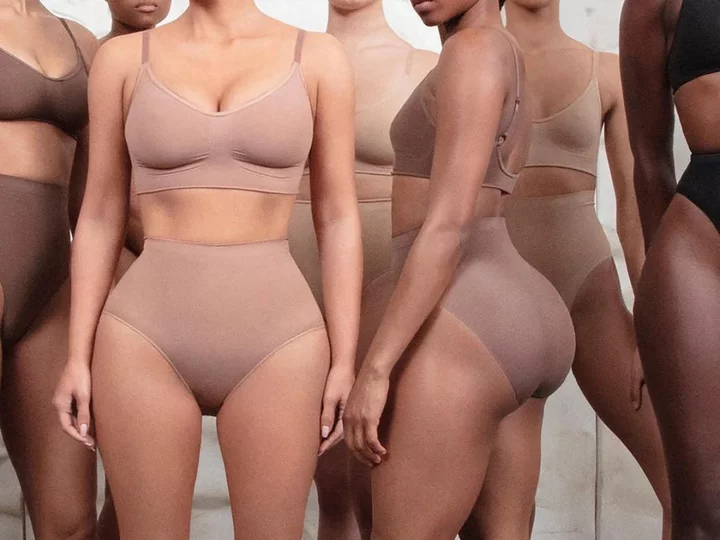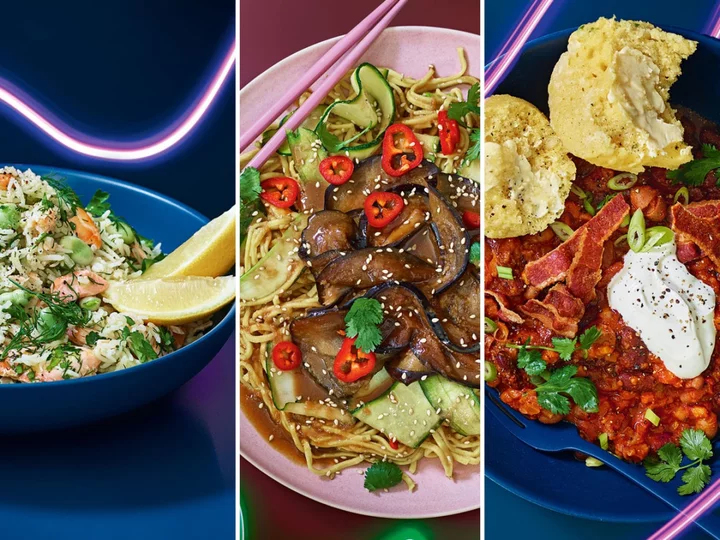
Jonnie Irwin explains why he hasn’t told sons about his terminal cancer: ‘Let’s bury our heads in the sand’
Jonnie Irwin has opened up about why he hasn’t told his three children that he has terminal cancer. The A Place in the Sun presenter, 49, publicly revealed his diagnosis in November 2022 after his lung cancer spread to his brain. However, his young sons, who he shares with wife Jessica Holmes, do not know that their father is dying. Irwin says it would be difficult for them to understand his situation at this age: his eldest son Rex is four-and-a-half, while twins Rafa and Cormac are turning three this month. In a new interview with Hello! magazine ahead of Father’s Day, Irwin said: “I keep being asked, ‘Are you going to tell them?’ but tell them what? “It would be horrible news that they’d have to get their heads around. And it would confuse the hell out of Rex – he’s got a shocking enough day coming. Let’s bury our heads in the sand for as long as possible.” In the meantime, Irwin and Holmes are trying to give their children a sense of normalcy by continuing to teach and play with them. Holmes described the presenter as a “great dad and a big kid himself”, adding: “All the boys gravitate to him when they want to show off and get his attention. They’re aware that Jonnie needs his rest and can’t always jump up and play football for hours, but they’re more than happy snuggled up on the sofa, watching a movie. “Story time is a big thing at bedtime and that is something I know Jonnie treasures with them.” In November, when Irwin first revealed his diagnosis, he said Rex “doesn’t need to know” about his illness yet. “We make fun of my hair – he calls it my ‘spiky head’ – but as far as he’s concerned, his dad is normal and why would I shatter that innocence?” Earlier this month, Irwin was admitted to hospital to be “monitored” as his treatment continues. He shared in an Instagram post that he was admitted to keep an eye on a “changeover in my pain management regime”. In an appearance on the OneChat podcast by insurer AIG Life, Irwin said he had been close to dying “at least twice”. “You lose your memory, you lose your patience. I have got a very short temper. It’s not made me a better person, that’s for sure,” he admitted. However, Irwin emphasised that he prefers to think of his situation as “living with cancer, rather than dying from cancer”. Read More A Place In The Sun’s Jonnie Irwin admitted to hospital amid terminal diagnosis Jonnie Irwin says he’s been ‘close to death’s door twice, at least’ Jonnie Irwin says going public with terminal cancer diagnosis was day he began ‘living again’
1970-01-01 08:00

Sharon Horgan says she has PTSD from daughter’s health scare
Sharon Horgan has opened up about having post-traumatic stress disorder (PTSD) after her eldest daughter was diagnosed with meningitis as a baby. The Irish actor, who will star in the forthcoming BBC One drama Best Interests with Michael Sheen, said she drew on the experience in order to play her character in the new series. Horgan’s daughter survived the life-threatening illness, but it left an “aftershock” on her mother. “We were so unbelievably lucky and we know that,” the Bad Sisters star told The Times in a new interview, published today (Sunday 11 June). “But the aftershock – there’s definitely PTSD and I dealt with any of my second daughter’s illnesses with blind panic because you always think, ‘If it can happen, why couldn’t it happen again?’” Both of Horgan’s daughters, Sadhbh and Amer, are now teenagers. She shares them with her ex-husband, Jeremy Rainbird. Best Interests tells the story of Nicci (Horgan), a mother who sues the NHS after doctors decide her Marnie (Niamh Moriarty) should be taken off life support after her condition, muscular dystrophy, deteriorates. Horgan stars opposite Sheen, who plays Nicci’s husband Andrew. In the show, Andrew is torn between his love for Marnie and his unwillingness to support his wife’s case. The friction between Nicci and Andrew shows that they “had a real relationship that has difficulties”, Horgan said. “When things get really, really bad, the accusations are there, a certain amount of finger-pointing, which happens anyway, just even in normal parenting,” she explained. After her divorce from Rainbird in 2019, Horgan said the adjustment to co-parenting made her doubt if she was a good mother. During an appearance on Desert Island Discs in 2020, she told host Lauren Laverne: “I was fun mum for years. I entirely thought that was my role but that changes when you co-parent. “Everything changes and you take on a lot more roles and I am much more practical than I was, and I think that is a positive thing.” She continued: “It had some dips in the middle where I thought, ‘Oh, that thing I thought I was, which was a good mother, I am not entirely sure about’. “When you bring anything like that into your kid’s life it’s tricky, when you turn the roles upside down, but it balances out and everything eased back.” Read More Shapewear is booming, and body image experts are worried: ‘It’s really dangerous’ Chris Hemsworth thanks wife Elsa Pataky for her ‘forgiveness’ Kelis addresses Bill Murray dating rumours for the first time Sharon Horgan opens up about ‘aftershock’ after daughter’s meningitis Jamie Foxx’s rep addresses conspiracy Covid vaccine left actor ‘paralyzed and blind’ Debate sparker over parent who wouldn’t give her daughter any birthday cake
1970-01-01 08:00

Wales adoptees hope to break taboo of identity struggle
A podcast featuring Welsh adoptees aims to tackle myths about adoption.
1970-01-01 08:00

How to shop for and cook Japanese food at home like a pro
The dinner rotation is an unspoken, yet essential schedule. Most of us have five or six reliable recipes tucked away in our back pockets, ready to be pulled out at a moment’s notice. Sometimes this means cooking the same dishes week in, week out. Venturing outside this routine should be an exciting prospect. Maybe you’ve been inspired by a travel documentary or a new cookbook caught your eye. It doesn’t look that hard, right? But hunting down the right ingredients can feel like a minefield when you don’t really know what you’re looking for or even where to find them. Shopping well is crucial for success in the kitchen. God only knows the number of times I’ve come home with the wrong thing or given up because I was overwhelmed by the supermarket aisles. What if I end up wasting money on a new meal that turns out catastrophic? Some cuisines are more daunting than others. Japanese food has such a reputation for perfection that the idea of making anything other than a katsu at home terrifies me. But it wouldn’t be so scary if I had a real-life expert to walk me through the supermarket shelves, show me what to look for and demonstrate that I could indeed be churning out beautiful sushi, delicious broths and other Japanese dishes from my humble kitchen. Enter: cookbook author and teacher, Atsuko Ikeda, who has offered to take me to an Asian cash and carry to teach me how to shop for Japanese ingredients. We meet at Tazaki, a major distributor of Asian ingredients in the UK that has a warehouse in North Greenwich. It was previously owned by SeeWoo but was acquired by Tazaki last year and is currently in the process of revamping stock. However, it still carries just about everything you need to get started on a Japanese culinary adventure. Ikeda, who has authored three cookbooks on Japanese small plates, comfort food and sushi, is a frequent visitor. We begin by perusing the fresh ingredients, like daikon (white winter radish), whole lotus root and mustard greens. The whole lotus root can be sliced thinly and fried to make crispy lotus chips, while the snow-white daikon can be grated into sauce or cubed and added to soups. But we’re starting simpler. Ikeda picks up shimeji mushrooms, small round cap fungi with medium-length stems that grow from a single base. These have an earthier flavour and are denser in texture than regular button or chestnut mushrooms, which means they retain their size and shape a little better. Spring onions, avocado and carrots also make it into the basket, common vegetables that can be found in any supermarket. We move onto carbs and delve into the rice section. As Ikeda is teaching me how to make sushi later, she explains that it is made with Japanese short-grain rice; it has a more glutinous, starchy texture than long-grain rice, which is more popular in the UK. This starchy quality of short-grain rice makes it stickier, an essential feature to make sure sushi rolls and nigiri bites don’t fall apart. A trusted brand for most Japanese ingredients, including sushi rice, is Yutaka, which can be found almost anywhere – I’ve seen it stocked in my local fishmonger. Plenty of other brands abound, with some supermarkets even providing their own brand products, but Ikeda’s recommendation goes straight into my basket. She points out a variety of noodles, and we’re talking much more than udon. There are bouncy shirataki noodles, almost transparent noodles made from konjac yam that can be eaten hot or cold. You can purchase frozen ramen noodles if you’re experimenting with making your own ramen, but Ikeda winks as she tells me she usually just goes to her favourite ramen shop when she’s craving it. Soba noodles, which can be bought dried, are perfect for the summer when tossed into a cold peanut sauce with an assortment of vegetables. The list goes on and on, but Ikeda reassures me that most noodles are versatile and it mainly depends on what type of texture you’re going for rather than flavour. Next is the condiments aisle, where miso resides (can miso be considered a condiment? I’m not so sure). Miso is, of course, a must-have staple. Ikeda points out three types: white miso, sweet rice miso and barley miso. Later, when we taste them, I’m surprised to learn how vastly different they taste from one another. The white miso, which is the most common type used in recipes, has a slight tang and a savouriness that makes your mouth water, while the barley has a deeper, maltier flavour that is mcuh more comforting. I highly recommend buying different types to taste for yourself. Ikeda also introduces me to yuzugosho, a spicy, tart condiment containing the yuzu fruit and fiery green chillies. It brought a tear to my eye, both from the heat and delicious flavour. Ikeda also teaches me that most commercial wasabi contains more horseradish than wasabi, so buyer beware: if you’re seeking the real deal, you may have to be prepared to shell out more money than you initially think. Some brands are 100 per cent horseradish, marketed as wasabi, so checking the label is essential. The same goes for mirin, a Japanese sweet rice wine which varies in alcohol content. A good rule of thumb is that the cheaper the mirin, the lower the alcohol content. Soy sauce is another staple for most Asian cuisines, but there are differences. Ikeda prefers to use tamari soy sauce, which is thicker and, I find, not as intensely salty as the soy sauce you usually get in tiny fish-shaped plastic bottles from takeaways. At home, I’m a Kikkoman soy sauce fan, but Ikeda recommends Yutaka’s organic tamari soy sauce for a more mellow, sweeter flavour. In terms of proteins, it depends on what dish you want. We’re focused on fish, particularly sushi-grade salmon, which you can buy from Tazaki or most fishmongers. This is where I’m especially nervous, because it’s easy to get the cut wrong. However, knowledgeable fishmongers are your best friends when it comes to choosing the cut, so ask plenty of questions. Ikeda shows me how to slice the salmon for different types of sushi rolls and nigiri, as well as how to steam the fish in a baking parchment parcel, slathered in miso and accompanied by the shimeji mushrooms we’d purchased earlier. You can also add fish roe or masago caviar to your Japanese dishes. The bright orange spheres add a unique saltiness and a satisfying texture to sushi, but can also be used to top rice dishes or stirred through Japanese-inspired pastas. A reliable brand is Elsinore, which can be found in Waitrose. I still find the idea of making sushi daunting, but the supermarket aisles no longer feel so intimidating now that I have a clearer idea of what to look for. It reminds me of how fun it is to try something new in the kitchen and, armed with cookbooks from the experts, the delicious results will keep me coming back for more. Read More Grace Dent’s quick and easy recipes that only require the microwave Forest Side, review: Cumbrian produce elevated to Michelin-starred proportions Showstopping BBQ main dishes for a hot grill summer 7 TikTok food hacks that actually work Saltie Girl in Mayfair will make you happy as a clam – as long as you can afford it Chef Ravinder Bhogal: Vegetables are the secret to saving money
1970-01-01 08:00

Shapewear is booming, and body image experts are worried: ‘It’s really dangerous’
In a number of scenes in 2001’s Bridget Jones’s Diary, our heroine – a thirtysomething singleton played by Renée Zellweger – squashes the skin of her lower torso into an array of Lycra shapewear, all in an attempt to make herself appear slimmer. When Hugh Grant’s Daniel Cleaver sets his eyes on her high-wasted, nude-coloured underpants in one memorable scene, Bridget blushes with embarrassment. “Well, hello mummy,” Daniel purrs. At the time of the film’s release, control shapewear – or tummy-tucking underwear designed to smooth its wearer – was marketed predominantly at people like Bridget, someone who was told by society she was “fat” or undesirable unless she had a flat stomach. Today, though, shapewear is branded differently, marketed to young women as a sexy, must-have fashion accessory. Shapewear products are not only promoted as stomach-smoothing fixes, but for anyone who wants a narrow waist or their figure to resemble a contoured, Kardashian-style hourglass. Skims, Kim Kardashian’s self-owned shapewear brand that she founded in 2019, sells viral sculpting bodysuits geared towards achieving this particular body shape. They start at £70. Since the launch of Skims, as with anything that a member of the Kardashian clan wears or makes, fast fashion knock-offs have swelled the market. Online retailer PrettyLittleThing, which has a murky track record of contributing to a harmful cycle of fast fashion, sells duplicates of the Skims viral bodysuit for around £20. They also sell waist trainers – a corset-style casing worn underneath clothes to aggressively teach your waist to be narrow – for just £12. “Doll cinch your waist in an instant with this waist trainer,” the item’s description reads. The product has boning to make it stiff and restrictive. Venture onto TikTok and you’ll find viral dresses with Spanx-style shapewear, designed to minimise the width of a person’s waist and accentuate their bottom, built into the clothing itself. While Skims is not solely responsible for this recent boom in shapewear, it has contributed to transforming how we view it – Bridget’s “granny pants” are now glamorous and aspirational. For the brand’s latest collection, for example, buzzy British singer-songwriters Raye and PinkPantheress were enlisted to promote it, along with viral Bronx rapper Ice Spice. The resulting campaign wouldn’t look out of place in the pages of Vogue. What this marketing tells us is that fashion isn’t just about the garments you wear, but the apparently malleable shape of the body on which they’re worn. Early shapewear emerged in the 16th century, not as a trend or body sculpting device, but for practical support. Karolina Laskowska, a lingerie designer and director of the underwear archive The Underpinnings Museum, tells me that the primary purpose of shapewear back then was to support the body much in the same way that a contemporary bra is made to support the breasts today. “A pair of stays [a corset style bodice] would have offered bust and back support for women who worked,” she explains. “These styles were more functional and supportive, rather than trend-driven.” The beginnings of the shapewear we see today were first seen in the Sixties, when the invention of Lycra, a synthetic-based elastic fibre, allowed for stretchier fabrics. What Laskowska dubs the grandparent of modern shapewear was the “Little X Girdle” by a British brand called Silhouette. “It was a turning point for a shift from traditional structured corsetry into elasticated shapewear,” she says. The item was a seamless, pull-on girdle – an elasticated corset extending from waist to thigh – and was eventually licenced to sell in over 32 countries as turnover increased exponentially. We then saw the evolution of more comfortable, everyday shapewear, like those made by Spanx, an American brand founded in 2000. They’re so uncomfortable, but they’re so afraid of what others will think about them due to their body size Victoria Kleinsman By contrast, modern shapewear is now geared towards sculpting the body to appear differently underneath clothes. And now, fast fashion is getting involved, too. But lingerie designers like Laskowska are increasingly worried about the consumer physically “hurting” themselves with badly made undergarments. “We’ve seen fast fashion adopt corsetry and shapewear trends but it’s not made to fit the human anatomy, since it’s made to be as cheap as possible,” she says. She adds that people could “injure” themselves with elasticated shapewear if they buy a size too small, meaning they could potentially restrict their blood’s circulation. Victoria Kleinsman, a self-esteem expert and body love coach, works with women between the ages of 13 to 60, and says that she’s seen how her younger clientele are feeling the pressure to wear shapewear in order to conform to the cult of thinness. Some clients have bought pantyhose with built-in cushioning to make the bottom look larger and perkier. Others will wear layers of shapewear to sculpt the body, particularly the waist and stomach, to look slimmer or flatter. To Kleinsman, wearing modern shapewear allows people to apply an “IRL [Instagram] filter” to their bodies. She speaks to women each day who are “crying” to her on Zoom calls because they’re worried about what their bodies look like. “It’s to the point when it’s boiling hot weather [but] they’re wearing spandex shapewear and tights, and they’re so uncomfortable, but they’re so afraid of what others will think about them due to their body size.” The expert fell into her line of work after she struggled with an eating disorder – she also wore a waist trainer when she was dealing with her own body image issues. “I would go to the gym wearing it because apparently you ‘sweat more’ and therefore lose ‘water fat’,” she says. “Which is b******! It’s physically painful to your physical body and even more painful to your emotional and mental well-being.” Kleinsman doesn’t think that this type of elasticated shapewear has anything to do with fashion and it should not be marketed as such. “It’s really dangerous,” she tells me. “Shapewear gives you a fake ‘confidence’ but then underneath it all when that comes off, then, who are you?” The popularity of Skims and their various knock-offs doesn’t seem likely to decline any time soon, but Kleinsman is hopeful that more women will soon have epiphanies about the shapewear revival. “Fatphobia and body image trauma is still the norm,” she sighs. “There has never been more [appropriate] a time for us to embrace our natural bodies.” Read More ‘The models are skinnier than ever’: Has London Fashion Week stopped caring about body diversity? Hostage to fashion: Margot Robbie’s Chanel problem speaks to a wider red carpet crisis Jeans shopping is still a total nightmare Kim Kardashian says Kris Jenner gets ‘sad’ thinking of how fame changed her family Kanye West and wife Bianca Censori cause confusion with Sunday Service outfits Chanel’s classic 1926 little black dress added to fashion exhibition in Scotland
1970-01-01 08:00

Magic of the microwave: Forget the oven with these three quick and easy recipes
Joining the Dent family in 1985, our microwave had somewhat of a bad start. It arrived, fresh out the box from Comet, in the midst of an argument. My mam had not greenlit the purchase of this cumbersome stainless-steel cube, with a vivid orange door, that Dad and I were loading onto her already packed kitchen worktop. She did not share our enthusiasm for this magical, space-age item we’d seen on BBC’s Tomorrow’s World and knew would take our snacking into the future. She was mainly outraged at the whopping £100 sum I’d cajoled Dad into spending. “I don’t trust it,” said Mam, reeling off a list of concerns, including microwaved innards, catastrophic explosions and partially cooked food giving us rampant salmonella. The truth was a little less exciting: I remember us loading the first maris piper inside, pricked all over with a fork, blasting it on HIGH for seven minutes, hoping for a crisp, fluffy jacket spud, only to find a rock-hard lump with a thin, waxy skin that hissed and spat from the holes. “See? Useless!” said Mam. My dad and I were sheepish. But as the weeks went on, Mam’s attitude to the microwave softened. For a start, it was saving her a fortune on gas as we almost stopped using the hobs for tinned spaghetti, soup, baked beans, tinned custard. Plus, the defrost button meant we now had access to all those mystery items she’d deep-frozen months back. Potato became a thing of joy as we discovered “micro-mash” (real potato, already peeled, mashed and frozen). Mam and Dad worked, so now my brother Dave and I could rush home from school and warm up glamorous microwave meals we’d begged Mam for on the big Friday shop. Macaroni cheese in a plastic tray! Microwave chips in a box! We learned how to heat food thoroughly, stopping halfway to give it a stir, before lazing on the couch, watching Miami Vice with our microwave chicken chow mein, feeling like we were fully living the dream. Nowadays, I try to limit my intake of such shiny-packeted E-number-filled joys; but still, I can’t live without my small, sleek, silver microwave. Life is too short to use a pan for frozen peas or spaghetti hoops; and how would I live without a quick 800W blast to thaw and separate veggie sausages before hurling them in the air fryer, or to defrost frozen mince before whipping up a quick chilli? Some foodie types are snobbish about the microwave; I see it as a loyal friend who has had my back for over 30 years Watt’s on the menu? Make the most of your microwave to conjure up clever meals that save on time and energy use. These ingenious recipes are from Ocadolife. Easy perfect rice with smoked trout and broad beans If you have trouble boiling rice on the hob, you’re going to love this method. It’s super-easy and yields flawless results every time. Here, it’s teamed with a summery combination of pink fish, vibrant herbs and a zingy dressing. Serves: 4 Hands-on time: 15 mins | Total time: 20 mins, plus standing (based on an 800W microwave at full power) Ingredients, available from Ocado: 250g basmati rice, rinsed 500ml hot vegetable stock 300g frozen broad beans Zest and juice of 1 unwaxed lemon, plus extra wedges for squeezing 1 garlic clove, crushed or grated 2 tbsp olive oil handful of flat-leaf parsley, roughly chopped Small bunch of dill, roughly chopped 2 x 100g packs M&S Scottish Loch Trout Flakes Method: 1. Put the rice in a large microwave-safe bowl. Pour the stock over the rice; stir well. Cover (if using microwave-safe wrap, pierce to let the steam escape); sit the bowl on a microwave-safe plate to catch drips and microwave for 12 mins. Remove; leave to stand, covered, for 10 mins. 2. Meanwhile, put the broad beans in another microwave-safe bowl with a few splashes of water, cover with a microwave-safe plate and blast for 2 mins. Remove, tip into a colander and refresh under cold running water until cooled; drain well. 3. Stir the broad beans into the rice, with the lemon zest and juice, garlic, olive oil, most of the herbs and plenty of seasoning. Fold through the trout. Divide between 4 plates and scatter over the remaining herbs. Serve with lemon wedges for squeezing. Per serving: 428cals, 1 veg portion, 10g fat (2g saturated), 22g protein, 59g carbs, 2g sugar, 7g fi bre, 1.7g salt Saucy supper silky aubergine and courgette noodles Microwaving cooks food from the inside out, so you can say goodbye to spongy aubergines and hello to beautifully soft flesh that soaks up the marinade as it cooks. Serves: 4 Hands-on/total time: 20 mins (based on an 800W microwave at full power) Ingredients available from Ocado: 2 aubergines, each cut lengthways into 8 pieces 100g egg noodles 1 large courgette, peeled into ribbons Large handful of coriander, roughly chopped 1 red chilli, sliced 1 tbsp sesame seeds, toasted For the marinade: 4 tbsp soy sauce 3 tbsp rice wine vinegar 1 tbsp sesame oil 2 garlic cloves, crushed or grated 3cm piece ginger, grated 1 tbsp miso paste 1 tsp caster sugar Method: 1. Combine all the marinade ingredients in a large microwave-safe bowl. Add the aubergine; toss to coat. Cover (if using microwave-safe wrap, pierce a couple of times to let the steam escape); microwave for 12 mins, stirring halfway, until cooked through. 2. Meanwhile, put the noodles in a heatproof bowl and cover with boiling water. Leave to stand for 3 mins or until tender. Put the courgette ribbons into a sieve, then drain the noodles over them – the residual heat will soften the courgette slightly. 3. Divide the noodles and courgette between 4 plates. Top with the aubergines, spooning over any remaining sauce. Scatter over the coriander and chilli, sprinkle with the toasted sesame seeds and serve immediately. Cover leftovers and chill for up to 2 days. Reheat in the microwave until piping hot. Per serving: 357cals, 1 veg portion, 5g fat (1g saturated), 13g protein, 60g carbs, 9g sugar, 9g fibre, 3.4g salt, £1.37 per portion Smoky bean chilli with cornbread and crispy bacon With no frying odours or splattered grease, bacon in the microwave is almost too good to be true – especially teamed with this delicious chilli and cheesy cornbread. Serves: 4 Hands-on time: 20 mins | Total time: 30 mins (based on an 800W microwave at full power) Ingredients available from Ocado: Six rashers dry-cured smoked streaky bacon For the cornbread: 2 tbsp unsalted butter, plus extra for spreading (optional) 5 tbsp plain flour 5 tbsp fine cornmeal or polenta 1 tsp baking powder 1 tbsp caster sugar 2 medium eggs, lightly beaten 6 tbsp natural yoghurt 1 green chilli, finely chopped (optional) 50g cheddar, finely grated For the chilli: 150g soffritto mix (we used Cook With M&S Frozen Soffritto Base, defrosted) 1 garlic clove, crushed or grated 2 tsp ground cumin 2 tsp smoked paprika 1 tsp dried oregano 1 tbsp olive oil 2 x 400g tins mixed beans, drained (splash of liquid reserved) 350g passata To serve (optional): Soured cream Handful of coriander, leaves picked 2 salad onions, chopped Method: 1. For the cornbread, put 1tbsp butter into each of 2 large mugs (preferably straight-sided). Microwave for 20 secs or until melted. Carefully swirl the butter around in the mugs so it greases the sides, then tip the excess out into a mixing bowl. Set the mugs aside. 2. Add the remaining cornbread ingredients to the bowl, reserving a little of the grated cheese. Season well, then stir until combined. 3. Divide the mixture equally between the 2 mugs and sprinkle over the remaining cheese. Microwave them separately for 1½-2 mins or until risen and springy. Run a knife around the edge of the cornbread to loosen; turn out onto a wire rack to cool. 4. For the chilli, put the soffritto, garlic, spices, oregano and oil into a large microwave-safe bowl. Cook for 3 mins, stirring halfway. 5. Add the beans (and a splash of liquid), passata and seasoning to the bowl; stir well. Cover (if using microwave-safe wrap, pierce a couple of times to let the steam escape), and cook for 5 mins, stirring halfway. Leave to stand while you cook the bacon. 6. Put 2 sheets of kitchen towel on a microwave-safe plate and lay the bacon in a single layer. Cover with another sheet of kitchen towel. Microwave for 1 min, then check to see if it’s crisp and starting to curl. If not, continue cooking in 20-sec bursts, being careful not to burn it. Break into shards. 7. Uncover the chilli (open it away from you to avoid the steam) and ladle into bowls. Top with a dollop of soured cream, the coriander and salad onions (if using), and the bacon. Serve with the cornbread, buttered if you like, for scooping. Leftover chilli will keep covered and chilled for 3 days. The cornbread is best eaten on the day of cooking. Per serving: 613cals, 2 veg portions, 29g fat (12g saturated), 30g protein, 54g carbs, 10g sugar, 9g fi bre, 2g salt, £1.60 per portion Read More How to shop for and cook Japanese food at home like a pro Forest Side, review: Cumbrian produce elevated to Michelin-starred proportions Showstopping BBQ main dishes for a hot grill summer 7 TikTok food hacks that actually work Saltie Girl in Mayfair will make you happy as a clam – as long as you can afford it Chef Ravinder Bhogal: Vegetables are the secret to saving money
1970-01-01 08:00

Biparjoy: India state on alert over 'extremely severe' cyclone
Cyclone Biparjoy is likely to hit parts of India's Gujarat state on 15 June, the weather office has said.
1970-01-01 08:00

Shooting leaves 1 dead and 6 others hurt after uninvited guests showed up to a 19-year-old's birthday party in northern California, police say
An 18-year-old woman was killed and six others were wounded in a shooting at a birthday party in Antioch, California, early Sunday morning, police said.
1970-01-01 08:00

German shepherd wounded in Ukraine gets new start as Hungarian police dog
A German shepherd wounded during a rocket attack in northeastern Ukraine is now training with the police department in Hungary's capital
1970-01-01 08:00

Arikomban: How two states are struggling to contain a rice-loving elephant
Authorities attempt to find a permanent habitat for it as activists criticise its "brutal" treatment.
1970-01-01 08:00

‘Spiral hotdog’ cooking technique goes viral amid UK heatwave
An unusual method for cooking hotdogs has gone viral on TikTok after food influencer Carolina Gelen shared a tutorial video for “spiral hotdogs”. Gelen, who shares recipes with more than 560k followers on TikTok, posted her latest tutorial last week and has garnered more than 1.8m views in under three days. Her method of cutting hot dogs into a spiral before cooking them gives the sausages more surface area for caramelisation and toppings, she said. The home cook demonstrates inserting a skewer lengthwise into a hotdog and using a knife to cut around it at a 45-degree angle. This creates a spiral hot dog that lengthens but does not break apart. Gelen then cooks them in a cast iron pan over a fire and explained that the new shape makes the meat “open up in the pan”. “They caramelise beautifully and they can hold so many more toppings due to their shape,” she told viewers. “All those flavours and sauces will fall between those nooks and crannies and stay in between the buns.” Gelen recommends making her roasted red pepper salsa and pickle mayonnaise for toppings, but people who try her method can use whatever hot dog toppings they enjoy. She finished the video by assembling her hot dog, which was loaded up with her salsa, mayonnaise and mustard. @carolinagelen spiral hot dogs #hotdog #cooking #grilling #food ♬ Sunday - HNNY Viewers have been enjoying trying Gelen’s method of cooking hot dogs, with one person writing: “You just changed my life.” Another said: “This is genius. I only like grilled hot dogs and this will definitely maximise caramelisation.” A third added: “My hot dog life will never be the same thank you.” The video was also shared on Twitter and has gained a similar reception, with many users declaring they will try it out. “One of those tips that immediately strike you as game-changing and legit,” one person wrote. “Maillard reaction = flavour. And those new nooks and crannies can hold on to toppings better. “I’ll be 100 per cent doing with my hot dogs and bratwursts from now on.” Another said: “I did the spiral hot dogs thing tonight and I can confirm it’s got me a Michelin star.” Some people pointed out that this method is common in some cuisines, such as Filipino food, and confirmed it is a delicious way to prepare hot dogs. The viral tip comes as the UK is experiencing the highest temperatures of 2023 so far, with the mercury hitting 30C in most of the country on Saturday (10 June). Many will undoubtedly be having barbecues as the temperatures soar again today (Sunday 11 June) and can try Gelen’s method of cooking hot dogs. However, the Met Office has issued yellow warnings for thunderstorms across parts of England and Wales and some areas could be hit by torrential rain this weekend. Read More More thunderstorms and 30C temperatures forecast after hottest day of the year 7 things fitness experts want you to know about exercise during a heatwave Weather – latest: Health warning escalated as ‘extreme’ heatwave set to make UK hotter than Spain Schoolboy almost dies from swallowing magnets for TikTok challenge Woman shares honest review of New York City apartment TikTok mom slammed after making 5-year-old son run in 104 degree heat
1970-01-01 08:00

Is TikTok's 'clean girl aesthetic' officially dead?
TikTok is a breeding ground for the next big thing. What was once predominantly a Gen Z dance app has since evolved into a catalogue of lifestyle habits repackaged under quirky names. Single? You’re ‘dating yourself.’ Attend the gym? You’re a ‘health girlie.’ Organised and minimal? You’re living the ‘Clean Girl Aesthetic’. With over a billion views under the hashtag, the Clean Girl Aesthetic has dominated the app for some time now – and it doesn’t seem to be going anywhere soon. It has since adopted other areas of life such as health and mindfulness. So, what is it? For the blissfully unaware, the Clean Girl is a TikTok trend in which everything about someone’s life appears minimal and effortlessly chic. It is portrayed as being low maintenance. A ‘Day in the Life’ generally starts with an early alarm, followed by a smoothie and minimal makeup for a dewy 'no make-up' glow. The Clean Girl Aesthetic has since welcomed Pilates under its wing, often finished with a dash of bedtime journaling for good measure. @mirellagir ???♀️ #morningvlog #morningroutine #selfcare #thatgirlaesthetic #pilates #cleangirlaesthetic #aestheticroutine Sign up for our free Indy100 weekly newsletter While the lifestyle trend is proving popular across social media, some have argued that it isn’t as effortless as what meets the eye. Critics claim it actually takes more time, effort and money with five minute glazed ‘makeup-less’ looks being tied to £500 treatments. The trend isn’t shy of controversy either, being credited to mostly white influencers. Some have highlighted that aspects of the aesthetic (specifically the ‘beauty’ tutorials) have roots in other cultures. That said, it’s always important to understand the origin of trends across TikTok and give credit where due. The trend has since had a face-off with ‘Dirty Girl Aesthetic’, with Julia Fox declaring on EmRata’s High Low podcast: "Clean Girl Aesthetic is out." The model added: "It’s about, Dirty Girl." She went on to elaborate in a candid clip uploaded to her page, raising concerns about the said ‘rules’ of TikTok trends. "Just so you guys know, ageing is fully in. Like, fully. Dirty girl. Ugly. Not wearing clothes that fit your body type. Just fully wearing everything you want," she told her followers. @juliafox Ooooo I know this is gonna make the broke boys mad #OLDISIN Now, if we strip it back to basics, remove the label and the aesthetically pleasing TikToks, the ‘beauty ideals’ and bouji products, we’re left with a handful of seemingly unproblematic healthy habits. But, are they really effective as TikTok hypes them up to be – or are they merely a part of yet another internet fad? I spent the last month finding out. Now, I pride myself on being a morning person so 5am starts can't be that challenging, right? Wrong. The 5am club is a simple concept to understand – but much more difficult to carry out. You essentially rise at the ungodly hour in the name of productivity. During your time of solitude, you complete house chores, read, grab some breakfast and journal before starting the working day. Days 1-3 felt like a novelty and were filled with optimism and drive: journalling away, whipping up smoothies and taking long, hot showers. Then came along days 3-5 and my body was crying out for those additional two extra hours in bed. The 'snooze alarm' was being abused – and by day 7, I officially called it a day. I have full respect for the 5am rise and shiners, and admire that it's some people's bag – but it's a solid no from me. I ended up bored and restless. Not to mention, the constant reminder I could do all of these things at the end of the day with the same level of energy. Sadly, the first week of journalling my feelings, thoughts and emotions were dedicated to bitching about how tired I was from the dreaded iPhone alarm. But, once the two hours sleep were added back into my routine, we were onto a winner. It soon transformed into a mini mental health journey, allowing me to really gauge certain triggers and delve into feelings a lot deeper. One of the most surprising and unexpected finds for me was connecting the dots between sleeping and eating habits, prompting me to experiment with foods that perhaps weren't giving me the best time. It also allowed me to set my intentions for the day and helped me to stay on track with different areas of life, including fitness. Being the forgetful – and sometimes erratic – person I am, it really helped me slow down, unwind and actually remind me to follow through my my 'to do' lists. This brings me to Pilates: The latest fitness trend taking social media by storm – thanks to the likes of Hailey Bieber, Lori Harvey and Kourtney Kardashian. Even Harry Styles has been spotted giving the Reformer machine a go. You'll soon be humbled by what appears slow, effortless movements – as I learnt at The Health Lab. "Celebrity fitness secrets used to be kept under lock and key but now the more you share the bigger your community," Faye Bennett, Health Lab's studio manager and instructor told Indy100. "Pilates does come with a certain aesthetic as it is commonly very clean movements which appeal to the eye (disclaimer: it’s not always like that!)." "It is a sustainable style of fitness that you can ultimately do every day with no harm to joints. It’s low impact and the results are truly visible," Faye continues. "The short answer is, it works." Truth is, Pilates is far from a new concept and has been practiced since the 1920s. German-born Joseph Pilates worked as a circus performer, boxer and self-defence instructor in England in his early years, before serving as an orderly in an Isle of Man hospital where he helped patients unable to walk. He did so by attaching bed springs to hospital beds, later birthing the famous apparatus seen in most Pilates studios today. "I invented all these machines... it resists your movements in just the right way so those inner muscles really have to work against it. That way you can concentrate on movement. You must always do it slowly and smoothly. Then your whole body is in it," he famously once explained. Complete with 10 Reformer machines in an aesthetically-pleasing studio in the heart of Manchester, the Health Lab may look like an Instagrammer's playground – but it's much more than pretty pictures. You will put in work, through low-intensity movements that will leave you aching in places you didn't even think possible. Hand-in-hand with incredible instructors, experts and a passion for Pilates, I soon learnt there was much more to the phenomenon that meets the eye. Being a loyal high-intensity exerciser over the years, I initially couldn't wrap my head around how subtle slow-paced movements could make a difference to my body. I couldn't have been any more wrong. After a month of training 3-4 times a week, I noticed improvements in my posture, strength and flexibility. It also had a surprising effect on my mental health– especially when it comes to anxiety – as it really taught me to prioritise and focus on breathing techniques. "There’s an age old saying that 'you’re only as old as your spine,'" Faye says. "Pilates is both restorative and strengthening. It improves your posture and alignment so that when you do work out you can access those deep layers of muscle in charge of building strength from the inside out." Faye explains that the leaner muscles become, the faster the metabolism and protected joints become. "This means you will be less prone to injuries and generally feel more ease as you move. This comes from increased flexibility and mobility. We focus an awful lot on the core in pilates which gives you the ability to hold yourself taller, which takes pressure away from your spine and releases tension enabling a strong healthy spine. A healthy spine makes you feel younger, more agile and stronger." While Reformer Pilates can initially look and feel daunting, sessions are guided by well-informed instructors who are on hand to offer help and modifications suited to everyone's individual needs. It's pretty easy to grasp after just one session. "Just know, if you are finding that pilates burn or feeling a little bit wobbly, the rest of the class is too so you are never alone no matter what your experience level is," Faye adds. While my Clean Girl month failed in some areas (a girl loves her sleep), Pilates and journalling are two new positive additions I'll be taking forward with me. They've provided both mental and physical benefits, by adding routine, clarity and a clearer, more settled mindset overall. Maybe TikTok is onto something, after all. To find out more information about The Health Lab classes, click here. Have your say in our news democracy. Click the upvote icon at the top of the page to help raise this article through the indy100 rankings.
1970-01-01 08:00
